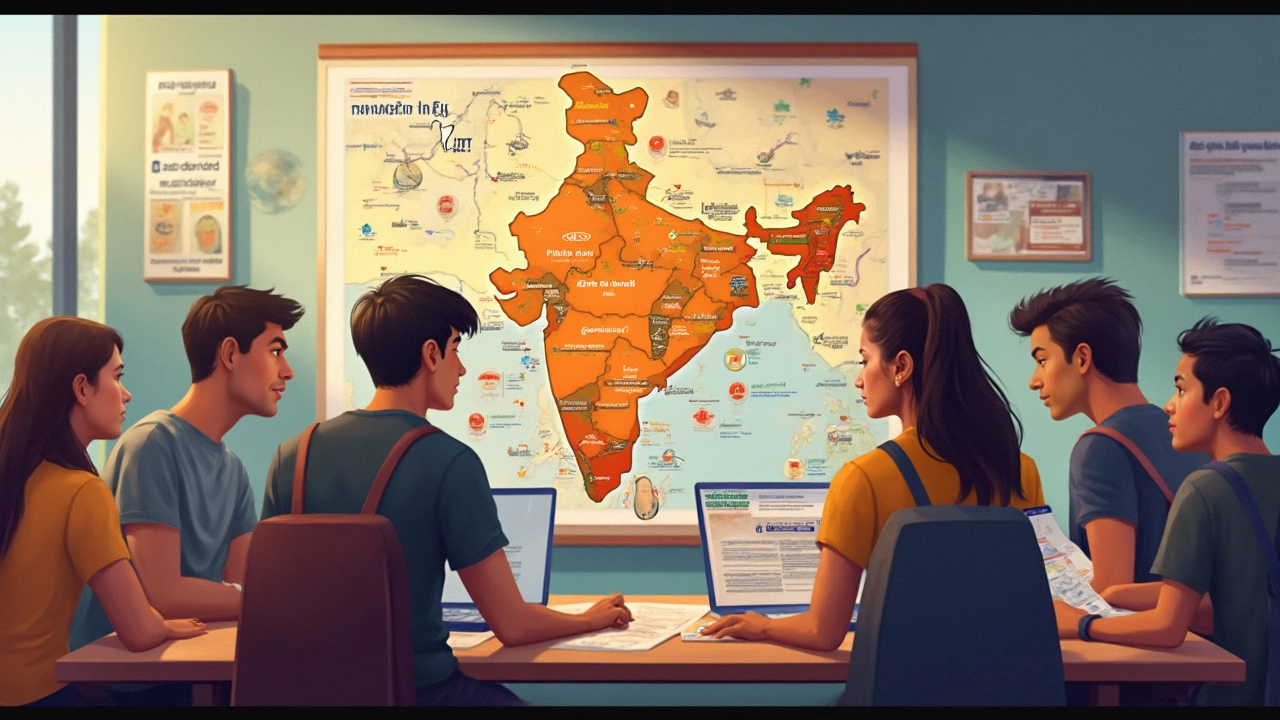Most people freak out when they hear '10,000 rank' for JEE Advanced, like it clearly shuts the IIT door. Actually, that's not the whole picture. There’s a big difference between what your rank means on paper and what it means when the counseling rounds start rolling.
With a 10,000 rank, scoring a seat in the older and top IITs for high-demand branches (think computer science or electrical) is realistically off the table. But there’s more to IIT than just those few big names and courses. You still have a legit shot at some of the newer IITs and lesser-celebrated branches. The game completely changes if you have a category rank or reservation, too.
If you’re stressing over what to fill in your JoSAA preference list, you’ll want to know where your chances actually stand. The choices you make can open up some sweet options you didn’t even see coming—if you play it smart and look past the obvious picks.
- What a 10,000 Rank Really Means
- IITs You Can Target: Cutoffs and Branches
- Smart Counseling Strategies and Seat Matrix
- Making the Most of Your Rank: Tips and Alternate Paths
What a 10,000 Rank Really Means
So, what does a 10,000 All India Rank in JEE Advanced actually get you? First off—don’t get caught up in the myth that it’s game over for IIT. This rank still gives you a real shot at the IIT system, especially if you plan your options right. In 2024, roughly 1.8 lakh students qualified for JEE Advanced. Only about 17,000-18,000 seats existed across all IITs, so hitting 10,000 actually puts you in the top 6% zone. That's nothing to scoff at.
The catch? Your IIT choice and branch selection become much narrower. Don’t expect Computer Science in IIT Bombay, Delhi, or Madras. But don’t shrug it off either—seats go vacant every year in branches people overlook, especially in newer and less-hyped IITs. Also, reservation categories can change everything. Knowing your category rank could open doors that seemed shut by your Common Rank List (CRL) position.
Here's a snapshot based on the latest data:
| Year | Total Qualified | Total IIT Seats | Your CRL Position |
|---|---|---|---|
| 2024 | 1,80,000 | 17,385 | 10,000 |
At 10,000, what you miss in 'brand value' for core branches can be made up with clever choices. Some students bag solid branches like Civil, Metallurgy, or lesser-known dual degree programs. Others use this as a launchpad for branching into analytics, consulting, or even non-tech careers thanks to the IIT tag.
If you have a category rank (EWS/OBC/SC/ST), check the round-wise cutoffs. Sometimes, category cutoffs for courses—like Electrical Engineering at IIT Mandi or Chemical at IIT Goa—can go comfortably beyond 12,000 or even 16,000. Don’t assume you’re out of the race until you’ve seen those numbers for your category and year.
Bottom line: a 10,000 AIR isn’t the end, it’s just a fork in the road. What you do next decides whether you make the most of your shot at an IIT campus.
IITs You Can Target: Cutoffs and Branches
Let’s get to the part everyone talks about after seeing a JEE Advanced All India Rank—what IITs will actually let you in with a 10,000 rank? Spoiler: it’s not all gloom and doom, but it’s not a cakewalk either. The options don’t just depend on the IIT—you also have to look at which branches are realistic. Don’t expect CSE at IIT Bombay, but don’t give up, because there are still choices to explore.
Here’s the rough outline of what’s usually on the table for someone with a rank around 10,000 (in the general category, open seat):
- Newer IITs—like IIT Jammu, IIT Bhilai, IIT Goa, IIT Palakkad, and IIT Dharwad—are your best bet, especially for core branches such as Civil, Mechanical, Chemical, and sometimes Electrical Engineering.
- Older ‘baby’ IITs, such as IIT Ropar, IIT Jodhpur, and IIT Gandhinagar, might offer lower-intake branches like Metallurgical or Environmental Science, but it gets competitive.
- Self-financed or interdisciplinary programs (Data Science, Engineering Physics, etc.) in these IITs may have higher closing ranks and could be worth a shot if you’re open-minded about the branch.
Don’t forget, every year the closing rank shifts a bit. Here’s a sample from 2024’s JoSAA Round 6 data (Open, Gender-Neutral, Last Accepted Rank):
| IIT | Branch | Closing Rank |
|---|---|---|
| IIT Jammu | Mechanical Engineering | 9990 |
| IIT Bhilai | Civil Engineering | 10,395 |
| IIT Dharwad | Electrical Engineering | 9695 |
| IIT Jodhpur | Metallurgical & Materials Science | 10,110 |
| IIT Palakkad | Civil Engineering | 10,252 |
Of course, category reservations change the game entirely. For example, if you’re OBC-NCL, SC, or ST, those same IITs can open up much better branches or even some in the older IITs with this rank. That’s why always check the latest cutoffs by your category and be ready to act fast during counseling rounds.
Quick tip: branches like Engineering Physics, Material Science, and even some emerging ones (like Energy or Environmental Engineering) don’t fill up as fast as core branches, so leaving them on your list can make all the difference between getting into an IIT or not.
In a nutshell, a 10,000 rank isn’t locking you out of the IIT club. You just have to widen your lens, be flexible on the branch, and pay attention to actual closing ranks and stats from last year.

Smart Counseling Strategies and Seat Matrix
If you’re sitting at a JEE Advanced rank around 10,000, the real game isn’t just about the rank—it’s about how you play your cards in JoSAA counseling. The seat matrix isn’t just random numbers; it’s your roadmap, and knowing how to use it can totally change your results.
First up, you have to put the right options in your preference list. Every year, thousands leave seats open—or worse, lose something decent—just because they didn’t fill out enough choices or had unrealistic combos in their list. Smart applicants add lots of branches and campuses, not just their dream picks. Here’s a quick rundown of what works best:
- Fill as many choices as possible, even if they're not your top dream branch or IIT. You can always refuse later, but you can't get assigned what you didn’t list.
- Check last year’s opening and closing ranks for every branch and campus—this gives you a reality check. For 2024, closing ranks for Chemical Engineering in IIT Ropar were around AIR 9800-10,500; in IIT Bhilai, Mechanical closed near 13,000.
- If you have a category rank (OBC, SC, ST, EWS), use your reservation benefit—cutoffs are very different. An OBC-NCL candidate with 10,000 common rank can usually still get core engineering branches in some newer IITs.
- Don’t ignore lesser-known branches. Courses like Metallurgical, Environmental, Engineering Physics, or dual degrees have lower cutoffs than CSE/EEE, and you can always look for a branch change or a good minor down the road.
Dr. Rajeev Kumar, a former professor at IIT Kharagpur, says it straight:
"The JoSAA seat matrix isn’t just data; it’s your opportunity map. Candidates who dig deep and fill all reasonable choices get more options, while those with tunnel vision often regret it."
To give you a sense of how the seat matrix looked in 2024 for the most accessible IITs at this rank:
| IIT Campus | Branch | Closing Rank (GEN) |
|---|---|---|
| IIT Bhilai | Mechanical Engg. | 12,974 |
| IIT Jammu | Civil Engg. | 12,580 |
| IIT Goa | Electrical Engg. | 10,181 |
| IIT Dharwad | Materials Science | 13,018 |
Remember, these numbers shift every year, but the logic stays the same. Study the seat matrix, don’t just guess. If your heart’s set on an older IIT, try for branches like Mining, Metallurgical, or even take up integrated programs—they show up at higher ranks at places like IIT ISM Dhanbad and IIT BHU.
And never leave your backup options blank. Whatever you do, don’t treat the counseling rounds like a lottery. Play smart and you’ll open more doors—even with a 10,000 rank.
Making the Most of Your Rank: Tips and Alternate Paths
Scoring around 10,000 in JEE Advanced probably leaves you with mixed feelings. But you know what? You’ve got more options than you might think. Let’s talk about how to turn your IIT JEE result into something valuable—whether that means choosing the right IIT or looking beyond.
First off, branch selection matters a lot. If you aren’t stuck on a particular stream, picking a less popular branch (like Metallurgy or Civil) in newer IITs gives you a high chance of grabbing a seat. Here’s a quick look at last year’s closing ranks for some branches at different IITs for the OPEN category:
| IIT | Branch | Last Round Closing Rank (2024) |
|---|---|---|
| IIT Bhilai | Civil Engineering | 11909 |
| IIT Jammu | Metallurgical & Materials Engg | 12987 |
| IIT Goa | Mechanical Engineering | 10152 |
| IIT Dharwad | Electrical Engineering | 9839 |
| IIT Palakkad | Data Science & Engineering | 9564 |
Clearly, if you have a category rank or EWS/OBC/SC/ST reservation, your options open up even more, often letting you access top branches in decent IITs. Always check the category-specific closing ranks from JoSAA data—these numbers matter.
If your heart’s set on a specific branch or older IIT, consider taking a drop and going all in for another attempt—lots of students do, and success stories aren’t rare. Only do this if you’re sure you can boost your score and not just because of peer pressure.
Looking beyond IITs isn’t a step down. NITs, IIITs, and some top state colleges offer solid engineering programs, sometimes with even better placements and alumni networks in certain branches. Plus, with a JEE Advanced rank, you’re eligible for the IISC and some IISERs—for science lovers, those are golden tickets.
Here’s what you should keep in mind to get the most value from your 10,000 rank:
- Make a wide JoSAA preference list—include all possible IITs and branches within your range.
- Look at past cutoffs (don’t skip the data!) and category-specific ranks.
- If you’re open-minded about location and stream, your odds are often better.
- Use JoSAA’s mock seat allocation rounds to fine-tune your list.
- Check for state quota advantages in NITs—sometimes a better deal than an IIT seat in a branch you don’t care for.
There’s no one-size-fits-all answer, but thinking smart and staying flexible can turn your JEE journey into something pretty amazing, no matter where you land.

